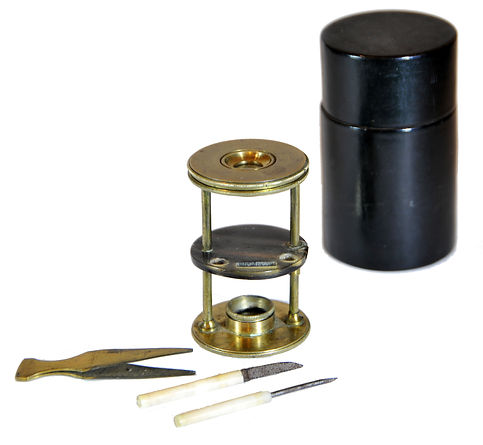

Withering-type botanical microscope, 1780
The “Withering-type Microscope” is named for its inventor, Dr. William Withering (1741-1799), an English physician and botanist who graduated with a degree in medicine 1766 in Edinburgh. Inspired by the taxonomical work and systematic classification of Carl Linnæus (1707-1778), Withering (1776) applied the Linnaean taxonomical system of classification to British plants in a seminal, two volume work, A Botanical arrangement of all the vegetables naturally growing in the British Isles. The earliest reference to a small botanical microscope of Withering’s design appeared in the first edition of this book. There, Withering indicated this microscope was developed for field dissections of flowers and other plant parts. While there is no surviving example of this exact design, close relatives of this type do exist, made either completely of brass or of ivory with brass pillars. Ivory models can be tentatively dated to 1776-1785, as by 1787 a newer model with a hollowed stage in an all-brass configuration already predominated. In turn, it was preceded by the brief appearance of a transitional brass model but with solid stage of ivory or horn (seen here). This version is extremely rare and must have been produced in very small numbers. By 1787 all these varieties were not recorded anymore in the literature.

Withering-type botanical microscope, 1780
The “Withering-type Microscope” is named for its inventor, Dr. William Withering (1741-1799), an English physician and botanist who graduated with a degree in medicine 1766 in Edinburgh. Inspired by the taxonomical work and systematic classification of Carl Linnæus (1707-1778), Withering (1776) applied the Linnaean taxonomical system of classification to British plants in a seminal, two volume work, A Botanical arrangement of all the vegetables naturally growing in the British Isles. The earliest reference to a small botanical microscope of Withering’s design appeared in the first edition of this book. There, Withering indicated this microscope was developed for field dissections of flowers and other plant parts. While there is no surviving example of this exact design, close relatives of this type do exist, made either completely of brass or of ivory with brass pillars. Ivory models can be tentatively dated to 1776-1785, as by 1787 a newer model with a hollowed stage in an all-brass configuration already predominated. In turn, it was preceded by the brief appearance of a transitional brass model but with solid stage of ivory or horn (seen here). This version is extremely rare and must have been produced in very small numbers. By 1787 all these varieties were not recorded anymore in the literature.
References: SML: A242712; Goren 2014.
References: SML: A242712; Goren 2014.
Prof. Yuval Goren's Collection of the History of the Microscope
J. P. Cutts Sutton & Son, Sheffield & London, Drum Microscope, 1840
While the cylindrical pocket microscope was invented by Benjamin Martin in ca. 1740, later variations of this design, made of brass and equipped with delicate rack and pinion mechanism, became popular during the first half of the 19th century. These microscopes were marketed by many makers and were often unsigned. This specimen is signed J. P. Cutts Sutton & Son, Optician to Her Majesty, Sheffield & London, but it is most likely the retailer rather than the maker. The case contains several objectives, forceps, bull’s eye lens, live box and ivory or bone prepared slides. Compactly packed in their mahogany boxes, these instruments were portable and could be easily taken to the field. The small “drum microscopes” made later, were less elaborate and cheaper variations of this general style.
In continental Europe, this design later developed through transitional phases into the continental microscope.
Inventory: YG-037

A thorough research by Prof. Brian Stevenson about the history of the J.P. Cutts company can be read here.
Like many signed English instruments of the 18th-19th centuries, the signature does not indicate that the instrument, or any part of it, were physically manufactured by the signed entity. It could have been the maker of the entire instrument (but that was rare before the introduction of mechanized production after the mid-19th century), the optician who made the lenses, the technician who outsourced the production of parts of the instrument and then assembled them and marketed it, or the retailer, agent of trader. Because these common microscopes are almost always identical, in most cases unsigned or bear signatures of various makers, they were obviously made for many retailers by several makers, each one of which was in charge of a different part of the kit. The lenses were most likely imported from France, where glass and lenses were by far cheaper than in England (Nuttall, 1979). These microscopes were marketed well into the 1850's, as indicated by the signature on this instrument which dates according to Stevenson's research to 1850-~1865. I believe that the production of these non-achromatic microscopes, which by that time were undoubtedly obsolete, ceased due to the introduction of the "Society of Arts Prize" microscope, which addressed the same clientele.


Like most of these microscopes, the set contained six non-achromatic objectives, marked with numbers from 1 to 6 with No. 1 being of the highest magnification. However, during a later stage of its use this microscope was equipped with an achromatic objective instead of No. 1. It is a two-part lens having two stacking button achromats, undoubtedly taken from a French microscope such as Chevalier's, and adopted to the thread of this instrument. Such modifications are known from many instances (see for example the Delebarre in this collection).

References: MHS: 26896, 43608, 43758, 43608, 81690, 46248, 36754, 99822; Boerhaave: V07117; Billings: P. 26, Fig. 50, AFIP 49068; SML: A56342, A196395, A196225, A212428, A61185, A601182, 1911-264; Whipple: 1806; Harvard: , 1303; Turner 1989: pp. 86-91; Nuttall 1979: 7; Turner 1981: 45; Sobel; Molecular Expressions.